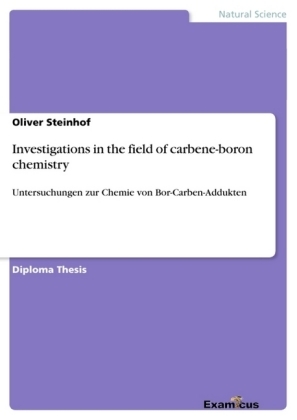
Investigations in the field of carbene-boron chemistry
Untersuchungen zur Chemie von Bor-Carben-Addukten
Seiten
2012
|
12002 A. 2. Auflage
GRIN Verlag
978-3-656-99781-8 (ISBN)
GRIN Verlag
978-3-656-99781-8 (ISBN)
- Titel nicht im Sortiment
- Artikel merken
Diploma Thesis from the year 2003 in the subject Chemistry - Materials Chemistry, grade: 1, Technical University of Braunschweig, language: English, abstract: From a long time ago attempts have been made to isolate carbenes. A big motivation behind the search for a stable carbene was the fact, that oxidation state II is well known for the late members of group 14, germanium, tin and lead. For lead +II is even the most stable oxidation state. Therefore it should be possible to produce a compound containing a carbon in oxidation state II, which is stable enough to be detected and possibly isolated and characterized. Additionally carbenes may be useful as building blocks in organic syntheses. They form complexes with a wide variety of main group elements and transition metals in both high and low oxidiation states. Many of these complexes are highly efficient homogeneous catalysts. Carbenes are defined as compounds possessing a divalent carbon in their structure. This carbon is bound to two adjacent groups by covalent bonds. It has two nonbonding electrons which may have parallel (singlet state) or antiparallel spins (triplet state). The preferred state depends on the relative energies of both states. If both orbitals are degenerate, the triplet state is favorable. Otherwise both electrons will occupy the orbital lower in energy with antiparallel spins. The simplest example of a carbene is methylene. The area of carbene boron chemistry is a relatively new area of research. Like most other fields of carbene research it has been revived by the discovery of stable carbenes by Arduengo in 1991. Until then only a few neutral borane adducts with electroneutral carbon bases were known. Most carbon bases are electron deficient on the carbon and therefore electrophiles. However, a nucleophile center is needed to bind to an electron deficient acceptor like borane, especially because boron is not able to provide any pi-backdonation like transition metal carbene complexes, as it lacks free electron pairs.The new nucleophile imidazole-2-ylides make neutral carbon borane adducts easily accessible. In 1993 Kuhn et al. found that borane adducts of these carbenes can be produced in high yields by allowing the carbene to react with BH3·Me2S complex. Other examples of boron adducts with nucleophilic carbenes are adducts with boron trifluoride and trimethoxyborate.Carbene boron adducts in which boron bears a single carbene substituent are easily accessible. Adducts with two or more carbene ligands on boron remain unknown.
| Erscheint lt. Verlag | 9.7.2012 |
|---|---|
| Sprache | englisch |
| Maße | 148 x 210 mm |
| Gewicht | 133 g |
| Themenwelt | Naturwissenschaften ► Chemie ► Allgemeines / Lexika |
| Schlagworte | Bor / Borverbindungen • bor-carben-addukten • Carbene • Chemie • Investigations • Untersuchungen |
| ISBN-10 | 3-656-99781-0 / 3656997810 |
| ISBN-13 | 978-3-656-99781-8 / 9783656997818 |
| Zustand | Neuware |
| Haben Sie eine Frage zum Produkt? |
Mehr entdecken
aus dem Bereich
aus dem Bereich
Eine chemische Warenkunde
Buch | Softcover (2022)
Wiley-VCH (Verlag)
CHF 41,85


